sensor LINCOLN NAVIGATOR 2023 Owners Manual
[x] Cancel search | Manufacturer: LINCOLN, Model Year: 2023, Model line: NAVIGATOR, Model: LINCOLN NAVIGATOR 2023Pages: 660, PDF Size: 14.04 MB
Page 5 of 660
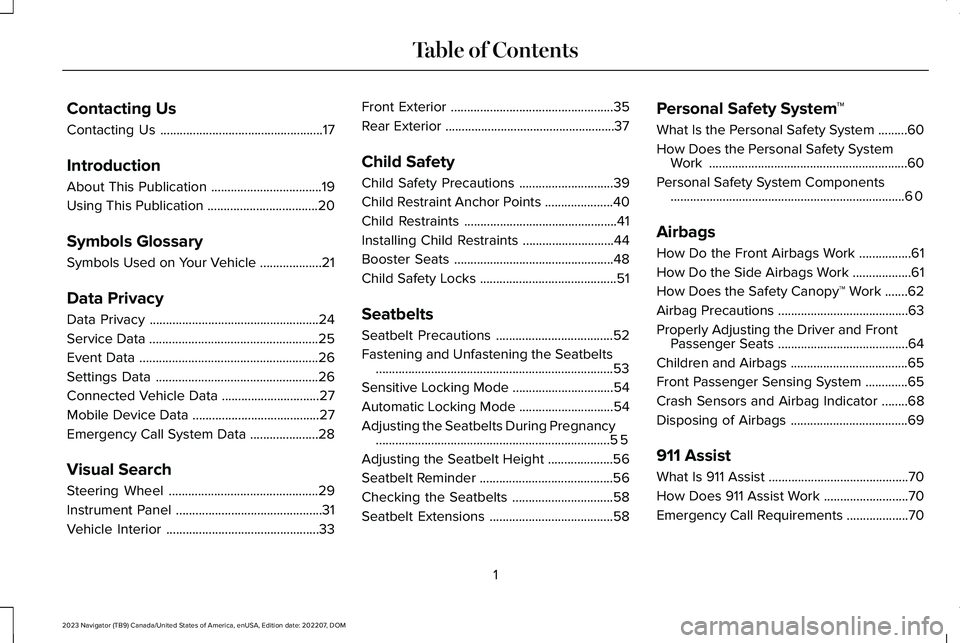
Contacting Us
Contacting Us..................................................17
Introduction
About This Publication..................................19
Using This Publication..................................20
Symbols Glossary
Symbols Used on Your Vehicle...................21
Data Privacy
Data Privacy....................................................24
Service Data....................................................25
Event Data.......................................................26
Settings Data..................................................26
Connected Vehicle Data..............................27
Mobile Device Data.......................................27
Emergency Call System Data.....................28
Visual Search
Steering Wheel..............................................29
Instrument Panel.............................................31
Vehicle Interior...............................................33
Front Exterior..................................................35
Rear Exterior....................................................37
Child Safety
Child Safety Precautions.............................39
Child Restraint Anchor Points.....................40
Child Restraints...............................................41
Installing Child Restraints............................44
Booster Seats.................................................48
Child Safety Locks..........................................51
Seatbelts
Seatbelt Precautions....................................52
Fastening and Unfastening the Seatbelts.........................................................................53
Sensitive Locking Mode...............................54
Automatic Locking Mode.............................54
Adjusting the Seatbelts During Pregnancy........................................................................55
Adjusting the Seatbelt Height....................56
Seatbelt Reminder.........................................56
Checking the Seatbelts...............................58
Seatbelt Extensions......................................58
Personal Safety System™
What Is the Personal Safety System.........60
How Does the Personal Safety SystemWork.............................................................60
Personal Safety System Components........................................................................60
Airbags
How Do the Front Airbags Work................61
How Do the Side Airbags Work..................61
How Does the Safety Canopy™ Work.......62
Airbag Precautions........................................63
Properly Adjusting the Driver and FrontPassenger Seats........................................64
Children and Airbags....................................65
Front Passenger Sensing System.............65
Crash Sensors and Airbag Indicator........68
Disposing of Airbags....................................69
911 Assist
What Is 911 Assist...........................................70
How Does 911 Assist Work..........................70
Emergency Call Requirements...................70
1
2023 Navigator (TB9) Canada/United States of America, enUSA, Edition date: 202207, DOMTable of Contents
Page 14 of 660
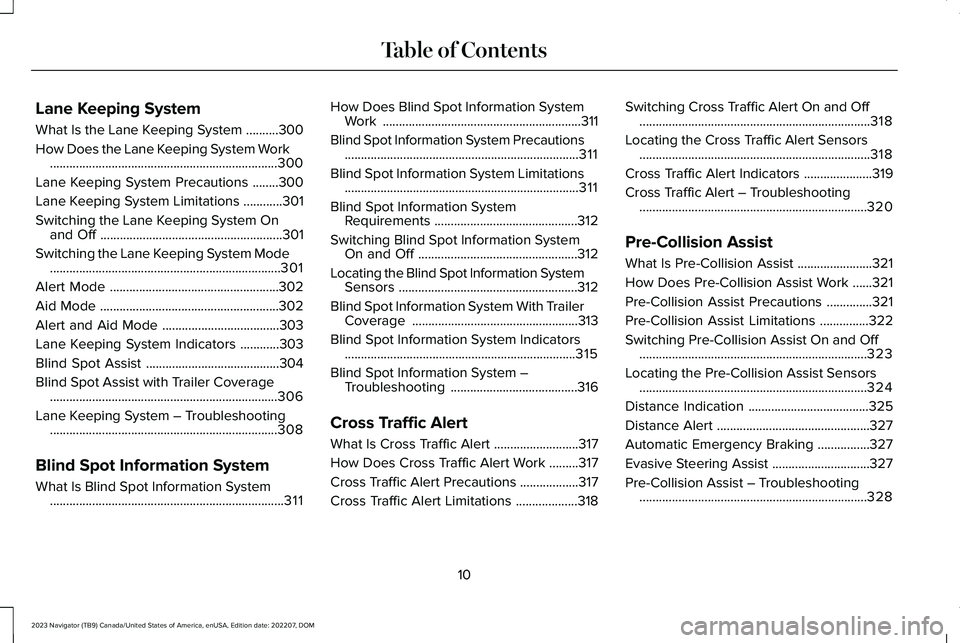
Lane Keeping System
What Is the Lane Keeping System..........300
How Does the Lane Keeping System Work......................................................................300
Lane Keeping System Precautions........300
Lane Keeping System Limitations............301
Switching the Lane Keeping System Onand Off........................................................301
Switching the Lane Keeping System Mode.......................................................................301
Alert Mode....................................................302
Aid Mode.......................................................302
Alert and Aid Mode....................................303
Lane Keeping System Indicators............303
Blind Spot Assist.........................................304
Blind Spot Assist with Trailer Coverage......................................................................306
Lane Keeping System – Troubleshooting......................................................................308
Blind Spot Information System
What Is Blind Spot Information System........................................................................311
How Does Blind Spot Information SystemWork.............................................................311
Blind Spot Information System Precautions........................................................................311
Blind Spot Information System Limitations........................................................................311
Blind Spot Information SystemRequirements............................................312
Switching Blind Spot Information SystemOn and Off.................................................312
Locating the Blind Spot Information SystemSensors.......................................................312
Blind Spot Information System With TrailerCoverage...................................................313
Blind Spot Information System Indicators.......................................................................315
Blind Spot Information System –Troubleshooting.......................................316
Cross Traffic Alert
What Is Cross Traffic Alert..........................317
How Does Cross Traffic Alert Work.........317
Cross Traffic Alert Precautions..................317
Cross Traffic Alert Limitations...................318
Switching Cross Traffic Alert On and Off.......................................................................318
Locating the Cross Traffic Alert Sensors.......................................................................318
Cross Traffic Alert Indicators.....................319
Cross Traffic Alert – Troubleshooting......................................................................320
Pre-Collision Assist
What Is Pre-Collision Assist.......................321
How Does Pre-Collision Assist Work......321
Pre-Collision Assist Precautions..............321
Pre-Collision Assist Limitations...............322
Switching Pre-Collision Assist On and Off......................................................................323
Locating the Pre-Collision Assist Sensors......................................................................324
Distance Indication.....................................325
Distance Alert...............................................327
Automatic Emergency Braking................327
Evasive Steering Assist..............................327
Pre-Collision Assist – Troubleshooting......................................................................328
10
2023 Navigator (TB9) Canada/United States of America, enUSA, Edition date: 202207, DOMTable of Contents
Page 42 of 660
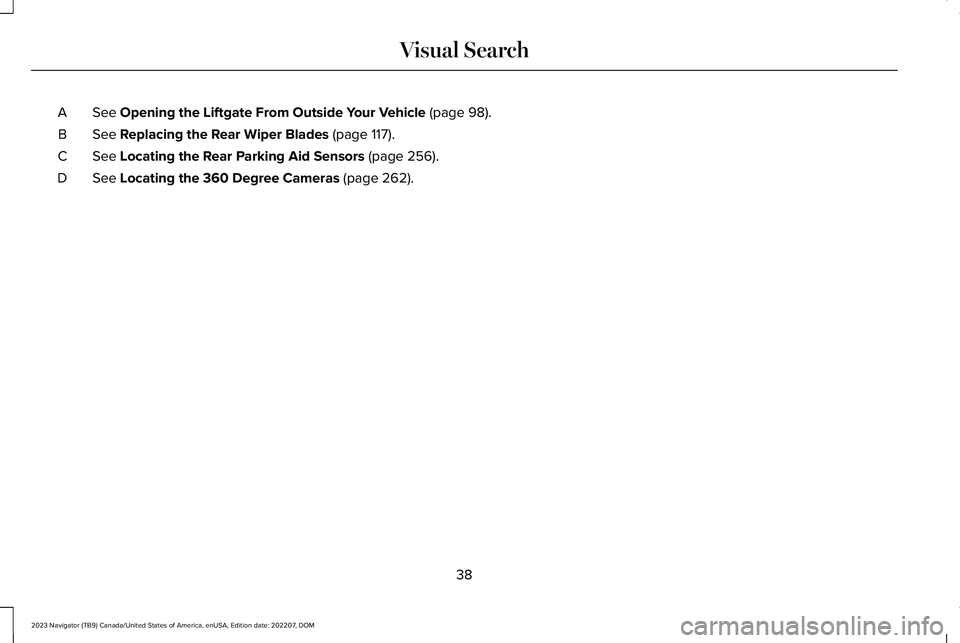
See Opening the Liftgate From Outside Your Vehicle (page 98).A
See Replacing the Rear Wiper Blades (page 117).B
See Locating the Rear Parking Aid Sensors (page 256).C
See Locating the 360 Degree Cameras (page 262).D
38
2023 Navigator (TB9) Canada/United States of America, enUSA, Edition date: 202207, DOMVisual Search
Page 57 of 660
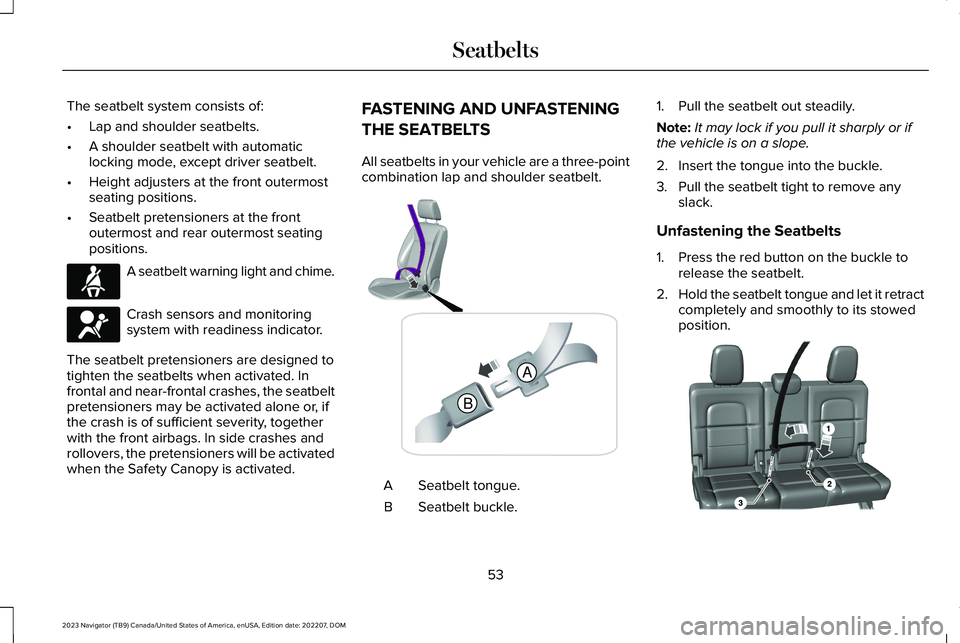
The seatbelt system consists of:
•Lap and shoulder seatbelts.
•A shoulder seatbelt with automaticlocking mode, except driver seatbelt.
•Height adjusters at the front outermostseating positions.
•Seatbelt pretensioners at the frontoutermost and rear outermost seatingpositions.
A seatbelt warning light and chime.
Crash sensors and monitoringsystem with readiness indicator.
The seatbelt pretensioners are designed totighten the seatbelts when activated. Infrontal and near-frontal crashes, the seatbeltpretensioners may be activated alone or, ifthe crash is of sufficient severity, togetherwith the front airbags. In side crashes androllovers, the pretensioners will be activatedwhen the Safety Canopy is activated.
FASTENING AND UNFASTENING
THE SEATBELTS
All seatbelts in your vehicle are a three-pointcombination lap and shoulder seatbelt.
Seatbelt tongue.A
Seatbelt buckle.B
1.Pull the seatbelt out steadily.
Note:It may lock if you pull it sharply or ifthe vehicle is on a slope.
2.Insert the tongue into the buckle.
3.Pull the seatbelt tight to remove anyslack.
Unfastening the Seatbelts
1.Press the red button on the buckle torelease the seatbelt.
2.Hold the seatbelt tongue and let it retractcompletely and smoothly to its stowedposition.
53
2023 Navigator (TB9) Canada/United States of America, enUSA, Edition date: 202207, DOMSeatbeltsE71880 E67017 BA E338014 E275033
Page 64 of 660
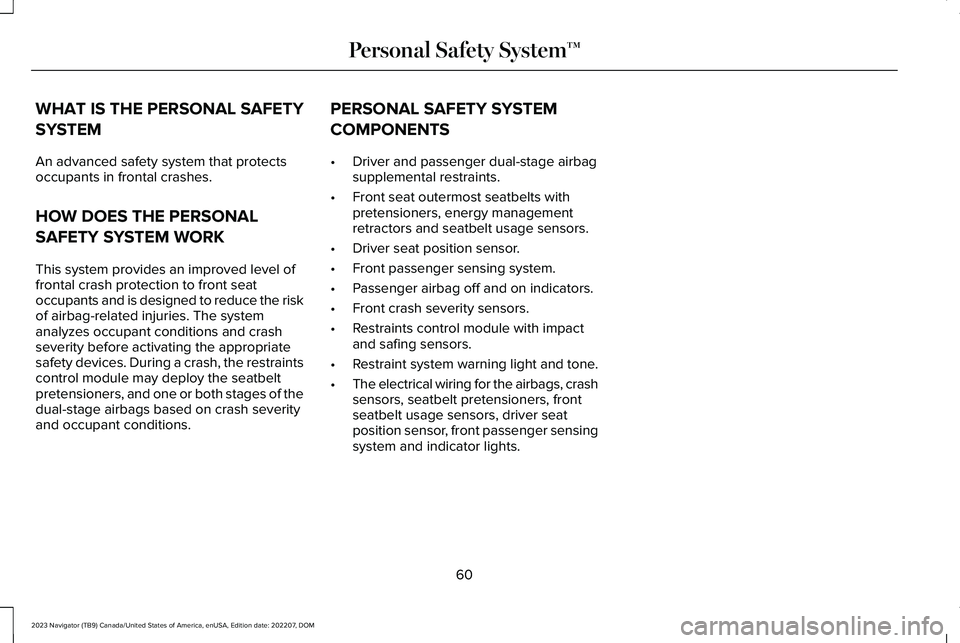
WHAT IS THE PERSONAL SAFETY
SYSTEM
An advanced safety system that protectsoccupants in frontal crashes.
HOW DOES THE PERSONAL
SAFETY SYSTEM WORK
This system provides an improved level offrontal crash protection to front seatoccupants and is designed to reduce the riskof airbag-related injuries. The systemanalyzes occupant conditions and crashseverity before activating the appropriatesafety devices. During a crash, the restraintscontrol module may deploy the seatbeltpretensioners, and one or both stages of thedual-stage airbags based on crash severityand occupant conditions.
PERSONAL SAFETY SYSTEM
COMPONENTS
•Driver and passenger dual-stage airbagsupplemental restraints.
•Front seat outermost seatbelts withpretensioners, energy managementretractors and seatbelt usage sensors.
•Driver seat position sensor.
•Front passenger sensing system.
•Passenger airbag off and on indicators.
•Front crash severity sensors.
•Restraints control module with impactand safing sensors.
•Restraint system warning light and tone.
•The electrical wiring for the airbags, crashsensors, seatbelt pretensioners, frontseatbelt usage sensors, driver seatposition sensor, front passenger sensingsystem and indicator lights.
60
2023 Navigator (TB9) Canada/United States of America, enUSA, Edition date: 202207, DOMPersonal Safety System™
Page 65 of 660

HOW DO THE FRONT AIRBAGS
WORK
The driver and front passenger airbagsdeploy during significant frontal and nearfrontal crashes.
The driver and passenger front airbag systemconsists of:
•Driver and passenger airbag modules.
•Front passenger sensing system.
•Crash sensors and monitoring systemwith readiness indicator. See CrashSensors and Airbag Indicator (page 68).
The airbags are a supplemental restraintsystem and are designed to work with theseatbelts to help protect the driver and rightfront passenger from certain upper bodyinjuries. Airbags do not inflate slowly; thereis a risk of injury from a deploying airbag.
Note:You will hear a loud bang and see acloud of harmless powdery residue if anairbag deploys. This is normal.
The airbags inflate and deflate rapidly uponactivation. After airbag deployment, it isnormal to notice a smoke-like, powderyresidue or smell the burnt propellant. Thismay consist of cornstarch, talcum powder (tolubricate the bag) or sodium compounds (forexample, baking soda) that result from thecombustion process that inflates the airbag. Small amounts of sodium hydroxide may bepresent which may irritate the skin and eyes,but none of the residue is toxic.
Contact with a deploying airbag may causeabrasions or swelling. Temporary hearingloss is also a possibility as a result of thenoise associated with a deploying airbag.
Because airbags must inflate rapidly and withconsiderable force, there is the risk of deathor serious injuries such as fractures, facialand eye injuries or internal injuries,particularly to occupants who are notproperly restrained or are otherwise out ofposition at the time of airbag deployment.Thus, it is extremely important that occupantsbe properly restrained as far away from theairbag module as possible while maintainingvehicle control.
Routine maintenance of the airbags is notrequired.
HOW DO THE SIDE AIRBAGS
WORK
WARNING: Do not place objects ormount equipment on or near the airbagcover, on the side of the front or rearseatbacks, or in areas that may come intocontact with a deploying airbag. Failure tofollow these instructions may increase therisk of personal injury in the event of acrash.
61
2023 Navigator (TB9) Canada/United States of America, enUSA, Edition date: 202207, DOMAirbagsE151127
Page 66 of 660
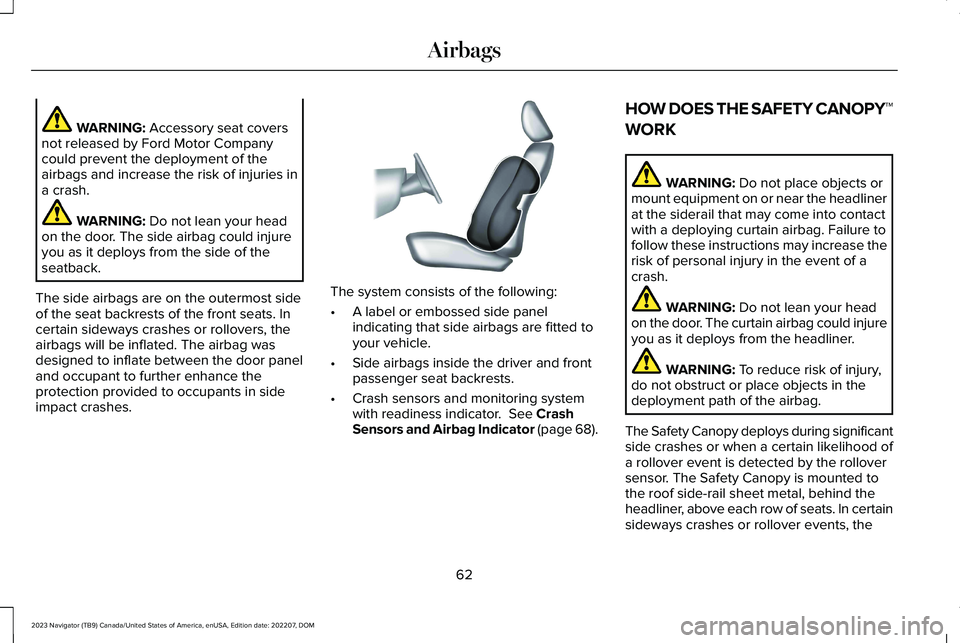
WARNING: Accessory seat coversnot released by Ford Motor Companycould prevent the deployment of theairbags and increase the risk of injuries ina crash.
WARNING: Do not lean your headon the door. The side airbag could injureyou as it deploys from the side of theseatback.
The side airbags are on the outermost sideof the seat backrests of the front seats. Incertain sideways crashes or rollovers, theairbags will be inflated. The airbag wasdesigned to inflate between the door paneland occupant to further enhance theprotection provided to occupants in sideimpact crashes.
The system consists of the following:
•A label or embossed side panelindicating that side airbags are fitted toyour vehicle.
•Side airbags inside the driver and frontpassenger seat backrests.
•Crash sensors and monitoring systemwith readiness indicator. See CrashSensors and Airbag Indicator (page 68).
HOW DOES THE SAFETY CANOPY™
WORK
WARNING: Do not place objects ormount equipment on or near the headlinerat the siderail that may come into contactwith a deploying curtain airbag. Failure tofollow these instructions may increase therisk of personal injury in the event of acrash.
WARNING: Do not lean your headon the door. The curtain airbag could injureyou as it deploys from the headliner.
WARNING: To reduce risk of injury,do not obstruct or place objects in thedeployment path of the airbag.
The Safety Canopy deploys during significantside crashes or when a certain likelihood ofa rollover event is detected by the rolloversensor. The Safety Canopy is mounted tothe roof side-rail sheet metal, behind theheadliner, above each row of seats. In certainsideways crashes or rollover events, the
62
2023 Navigator (TB9) Canada/United States of America, enUSA, Edition date: 202207, DOMAirbagsE152533
Page 67 of 660
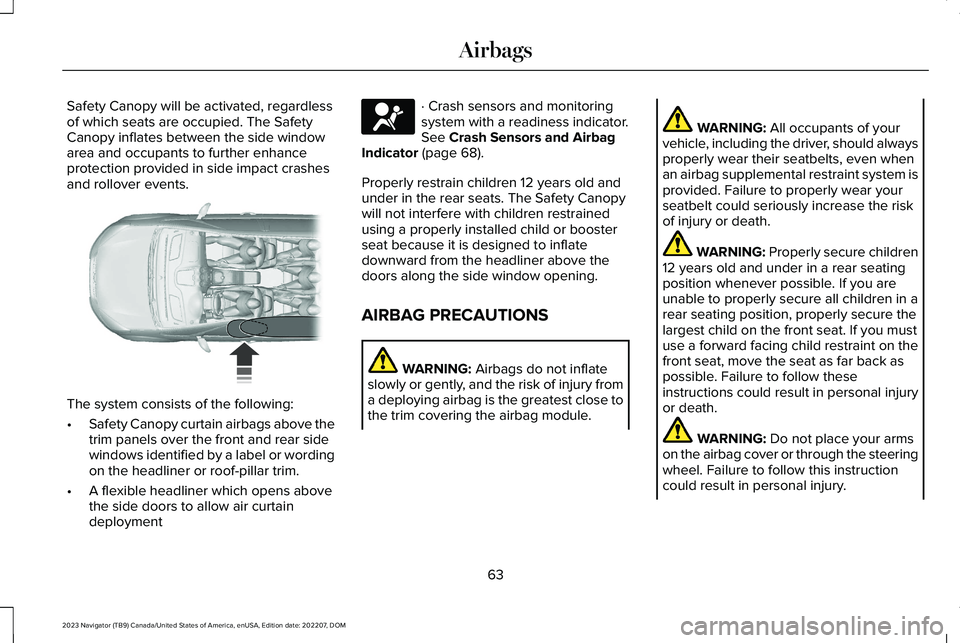
Safety Canopy will be activated, regardlessof which seats are occupied. The SafetyCanopy inflates between the side windowarea and occupants to further enhanceprotection provided in side impact crashesand rollover events.
The system consists of the following:
•Safety Canopy curtain airbags above thetrim panels over the front and rear sidewindows identified by a label or wordingon the headliner or roof-pillar trim.
•A flexible headliner which opens abovethe side doors to allow air curtaindeployment
· Crash sensors and monitoringsystem with a readiness indicator.See Crash Sensors and AirbagIndicator (page 68).
Properly restrain children 12 years old andunder in the rear seats. The Safety Canopywill not interfere with children restrainedusing a properly installed child or boosterseat because it is designed to inflatedownward from the headliner above thedoors along the side window opening.
AIRBAG PRECAUTIONS
WARNING: Airbags do not inflateslowly or gently, and the risk of injury froma deploying airbag is the greatest close tothe trim covering the airbag module.
WARNING: All occupants of yourvehicle, including the driver, should alwaysproperly wear their seatbelts, even whenan airbag supplemental restraint system isprovided. Failure to properly wear yourseatbelt could seriously increase the riskof injury or death.
WARNING: Properly secure children12 years old and under in a rear seatingposition whenever possible. If you areunable to properly secure all children in arear seating position, properly secure thelargest child on the front seat. If you mustuse a forward facing child restraint on thefront seat, move the seat as far back aspossible. Failure to follow theseinstructions could result in personal injuryor death.
WARNING: Do not place your armson the airbag cover or through the steeringwheel. Failure to follow this instructioncould result in personal injury.
63
2023 Navigator (TB9) Canada/United States of America, enUSA, Edition date: 202207, DOMAirbags E75004 E67017
Page 70 of 660
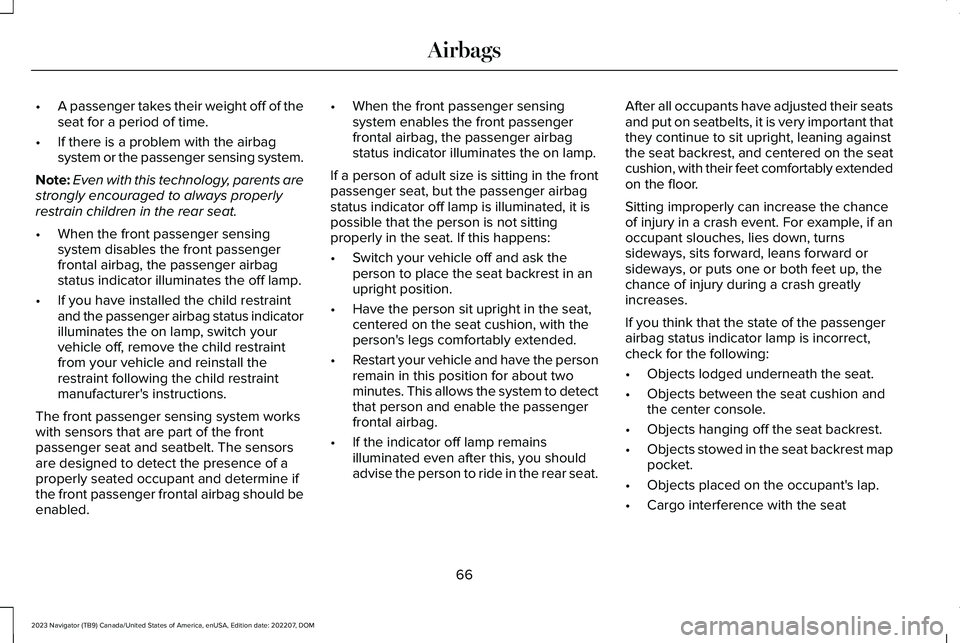
•A passenger takes their weight off of theseat for a period of time.
•If there is a problem with the airbagsystem or the passenger sensing system.
Note:Even with this technology, parents arestrongly encouraged to always properlyrestrain children in the rear seat.
•When the front passenger sensingsystem disables the front passengerfrontal airbag, the passenger airbagstatus indicator illuminates the off lamp.
•If you have installed the child restraintand the passenger airbag status indicatorilluminates the on lamp, switch yourvehicle off, remove the child restraintfrom your vehicle and reinstall therestraint following the child restraintmanufacturer's instructions.
The front passenger sensing system workswith sensors that are part of the frontpassenger seat and seatbelt. The sensorsare designed to detect the presence of aproperly seated occupant and determine ifthe front passenger frontal airbag should beenabled.
•When the front passenger sensingsystem enables the front passengerfrontal airbag, the passenger airbagstatus indicator illuminates the on lamp.
If a person of adult size is sitting in the frontpassenger seat, but the passenger airbagstatus indicator off lamp is illuminated, it ispossible that the person is not sittingproperly in the seat. If this happens:
•Switch your vehicle off and ask theperson to place the seat backrest in anupright position.
•Have the person sit upright in the seat,centered on the seat cushion, with theperson's legs comfortably extended.
•Restart your vehicle and have the personremain in this position for about twominutes. This allows the system to detectthat person and enable the passengerfrontal airbag.
•If the indicator off lamp remainsilluminated even after this, you shouldadvise the person to ride in the rear seat.
After all occupants have adjusted their seatsand put on seatbelts, it is very important thatthey continue to sit upright, leaning againstthe seat backrest, and centered on the seatcushion, with their feet comfortably extendedon the floor.
Sitting improperly can increase the chanceof injury in a crash event. For example, if anoccupant slouches, lies down, turnssideways, sits forward, leans forward orsideways, or puts one or both feet up, thechance of injury during a crash greatlyincreases.
If you think that the state of the passengerairbag status indicator lamp is incorrect,check for the following:
•Objects lodged underneath the seat.
•Objects between the seat cushion andthe center console.
•Objects hanging off the seat backrest.
•Objects stowed in the seat backrest mappocket.
•Objects placed on the occupant's lap.
•Cargo interference with the seat
66
2023 Navigator (TB9) Canada/United States of America, enUSA, Edition date: 202207, DOMAirbags
Page 71 of 660
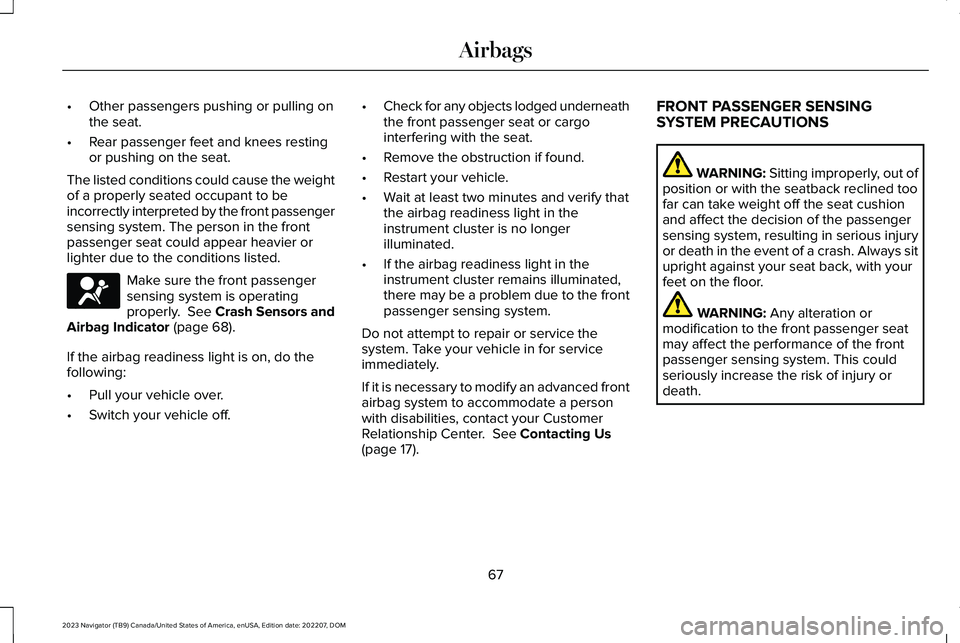
•Other passengers pushing or pulling onthe seat.
•Rear passenger feet and knees restingor pushing on the seat.
The listed conditions could cause the weightof a properly seated occupant to beincorrectly interpreted by the front passengersensing system. The person in the frontpassenger seat could appear heavier orlighter due to the conditions listed.
Make sure the front passengersensing system is operatingproperly. See Crash Sensors andAirbag Indicator (page 68).
If the airbag readiness light is on, do thefollowing:
•Pull your vehicle over.
•Switch your vehicle off.
•Check for any objects lodged underneaththe front passenger seat or cargointerfering with the seat.
•Remove the obstruction if found.
•Restart your vehicle.
•Wait at least two minutes and verify thatthe airbag readiness light in theinstrument cluster is no longerilluminated.
•If the airbag readiness light in theinstrument cluster remains illuminated,there may be a problem due to the frontpassenger sensing system.
Do not attempt to repair or service thesystem. Take your vehicle in for serviceimmediately.
If it is necessary to modify an advanced frontairbag system to accommodate a personwith disabilities, contact your CustomerRelationship Center. See Contacting Us(page 17).
FRONT PASSENGER SENSINGSYSTEM PRECAUTIONS
WARNING: Sitting improperly, out ofposition or with the seatback reclined toofar can take weight off the seat cushionand affect the decision of the passengersensing system, resulting in serious injuryor death in the event of a crash. Always situpright against your seat back, with yourfeet on the floor.
WARNING: Any alteration ormodification to the front passenger seatmay affect the performance of the frontpassenger sensing system. This couldseriously increase the risk of injury ordeath.
67
2023 Navigator (TB9) Canada/United States of America, enUSA, Edition date: 202207, DOMAirbagsE67017